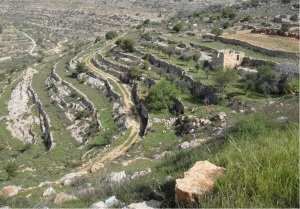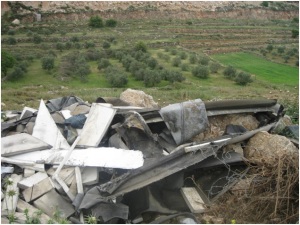
The Mate Yehude Regional Council in Israel and the West Bethlehem villages in Palestine are two partnering communities of FoEME’s Good Water Neighbors project (GWN) launched one decade ago to raise awareness of the water problems shared by Jordanians, Palestinians, and Israelis.Over the last months, FoEME staff reached out to stakeholders, decision makers and funding bodies to identify the priority projects needing advancement in those communities. This consultation resulted in the development of Priority Initiatives, a document designed as a roadmap to guide the efforts of stakeholders through cross-border project activities, which was released on the GWN conference that took place in September in Jericho. Here, we focus on an ambitious and necessary initiative to preserve a unique shared cultural landscape.

Walking around the Judean / Jerusalem Hills, South West from Jerusalem, one can see a remarkable landscape of terraced structures along the slopes. Springs and ephemeral streams located in the hillsides, over the Mountain Aquifer, have provided the foundation for traditional agricultural cultivation of olive groves, vineyards, fruit trees, and vegetables for generations. The terraces, built to increase the fertility of the land by capturing water and nourishing crops, are one of the most ancient examples in the world of agricultural structures. They are a direct outcome of both social and economic interactions of populations with the local hydro-geological system for over 3,000 years. However, at present, the integrity of this cultural landscape heritage, on both sides of the border, is severely at risk.
Within the Israeli area, in Mate Yehuda Regional Council, the pressure of urban development and the need for a growing transportation infrastructure conflict with the preservation of the landscape. The traditional terraced agricultural land have been gradually abandoned since 1948, and many springs are now dried up or polluted by runoff from agriculture, sewage, and gas infrastructure. In the West Bethlehem villages in the Palestinian area, illegal dumping of waste, urban development, the building of Israeli settlements and their subsequent bypass roads are in direct competition with conservation of this high valued landscape. A push towards modernizing the agricultural infrastructure in Palestine, away from traditional methods, leads to its further degradation.
Both Palestinians and Israelis bodies recognize the need for action to preserve this common heritage. In Battir, one of the West Bethlehem villages, the Village Council together with the UNESCO office in Ramallah have made great efforts to safeguard the terraces and raise awareness about their precious eco-cultural heritage. An integrated program proposes to extend the efforts and achievements made in Battir to other West Bethlehem villages, and in 2012 a proposed nomination document for UNESCO to recognize the area as a World Heritage in Danger was submitted. On the Israeli side, the Society for the Protection of Nature in Israel (SPNI) and the Nature and Parks Authority have carried out several studies that identified the outstanding cultural landscape and call for its preservation. In 2010, Nekudat Chen, a program of the Yad Hanadiv Foundation, explored the possibility for Israel to propose that the area be listed as a UNESCO World Heritage Cultural Landscape site. The work emphasized the continuity of the landscape without recognition of political borders between the Israeli and Palestinian sides.
Since 2001, FoEME has been extensively involved with local residents, municipal representatives and youth. A Neighbors Path has been created between Wadi Fukin and Tzur Hadassah in 2005, extended to Battir in 2011; FoEME has partnered with the Service Council on the Palestinian side to leverage investments in water supply and to study sanitation solutions for the five Palestinian villages concerned. FoEME staff and local community activists on both sides were integral in preventing the construction of the Separation Barrier planned in Wadi Fukin, and so they are now in Battir.
With this new Priority Initiative, FoEME seeks to expand its work in both communities to preserve the terraces and to promote community cooperation around ecotourism and sustainable agricultural development. Building on the work already undertaken by all parties, FoEME has put forth a project proposal to establish a comprehensive Master Plan with a trans-boundary vision of landscape conservation, green economies and cross-border ecotourism, based on public participation meetings to identify local community needs and constraints. FoEME focuses on empowering and building capacity of local communities to act as advocates for their cultural landscape. Youth and community members will be involved as “Terrace Trustees” and engaged in restoration and conservation workshops. Publicity through media outreach, community organizing, and information tours will help bringing national and international attention to the cultural and environmental significance of this landscape and preventing threats to its integrity.
The terraces have passed millenniums as a living, working ecosystem; it is through information exchanges between Mate Yehuda and the West Bethlehem villages that the people from both communities will preserve the traditional knowledge of terraced agriculture and spring management. FoEME will support cross-border training programs on organic farming, ecotourism and marketing, to create and develop green income opportunities for Palestinian and Israeli neighboring communities based on the unique landscape values of the area, such as cross-border farmers’ markets.
This post has been written by FoEME intern Amélie Joseph. Amélie holds a MA in agronomy and environment and is working with FoEME on water-related issues in agriculture, in Tel Aviv office.